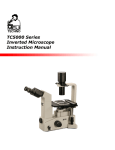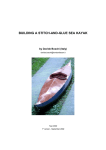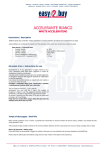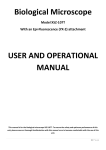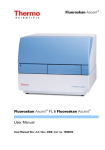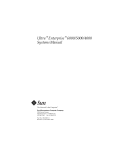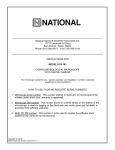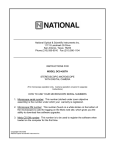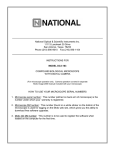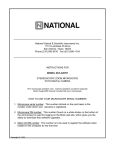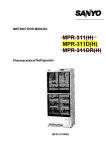Download Episcopic-Fluorescence Attachment EF-UPR-lll
Transcript
Motic Episcopic-Fluorescence Attachment EF-UPR-lll for BA400/BA600 User Manual Motic Incorporation Ltd. Prepared by Motic Instruments Inc. Canada This User Manual has been prepared for users of the EF-UPR-ll Epi-Fluorescence Attachment used in conjunction with the Motic BA400-600 Inverted Microscope. We are constantly endeavouring to improve our instruments and to adapt them to the requirements of modern research techniques and testing methods. This involves modification to the mechanical structure and optical design of our instruments. Therefore, all descriptions and illustrations in this instruction manual, including all specifications are subject to change without notice. This manual may not be reproduced or transmitted in whole or in part without Motic’s express permission. Motic Instruments Inc. Canada January 2007 1 Fluorescence The optical phenomenon that occurs when light absorbed by a material, creates a molecular excitation that causes the material to re-emit light at a different wavelength. Fluorescence Microscope for Epi-Fluorescence The technique of fluorescence microscopy with epi-illuminators (episcopic-illuminator) that is based on the adaptation of the vertical illuminator used in reflected light microscopy. The radiation emitted by the light source first passes through the exciting filter and is incident to a shortpass filter* (dichroic beam splitter). The radiation is then reflected into the objective, which also serves as a condenser. The objective concentrates the exciting radiation in the object field. Fluorescent light emitted from there, is collected by the objective and returned in the opposite direction to the short-pass filter, which directs it into the eyepiece through the barrier filter. *A filter designed to allow the passage of radiation of wavelengths shorter than a given limit. Motic Instruments Inc. Canada January 2007 2 Table of Contents 1.0 Names of Component Parts 2.0 Setting up the Instrument 3.0 Assembly 4.0 Microscopy 5.0 Troubleshooting Table 6.0 Care and Maintenance Motic Instruments Inc. Canada January 2007 3 1.0 Names of Component Parts Fig. 1 Epi - fluorescence Attachment EF-UPR-lll Lamphouse for Mercury Vapour lamp Light protective shield UV light shield tube Power supply unit Motic Instruments Inc. Canada January 2007 4 Epi-fluorescence Attachment Main Body Fig. 2 Shutter slider with filter holder Observation tube clap screw Field aperture diaphragm knurled ring Fluorescence attachment clamp screws Bayonet clamp ring Field aperture diaphragm centering screws Filter cube cover Knurled retaining screws Filter cube ID tag pocket UV light protective shield . Excitation method change over knob . UV Light Blocking Tube Lamp Centering Tool System Devices Motic Instruments Inc. Canada January 2007 5 2.0 Setting up the Instrument • Avoid placing the instrument in areas exposed to dust, vibration, high temperature and high humidity. • Avoid locations exposed to direct sunlight, under room lights. • Select location which allows easy access to power cord from products AC inlet in the event of an emergency. • Do not place power supply on a table mat. Motic Instruments Inc. Canada January 2007 6 3.0 Assembly 3.1 Microscope assembly Follow the instructions provided in the microscope manual. For the purpose of performing simultaneous observation with phase contrast, attach the appropriate phase contrast components referring to the specific instructions provided. 3.2 Installing the Epi-fluorescence attachment Please consult the illustrations provided while assembling the attachment 3.3 Required tools Allen hex keys: 2.5mm and 5mm (supplied with attachment). Before Starting Turn off the microscope power switch and unplug the power cord Motic Instruments Inc. Canada January 2007 7 3.4 Epi-fluorescence attachment Fig. 4 Fluorescence attachment clamp screws 3 2 Eyepiece tube clamp screw 1 1 Position Epi-fluorescence attachment parallel to the microscope arm and secure with 5.0mm hexagonal clamp screws. 2 Mount eyepiece tube on the Epi-fluorescence attachment and secure with 2.5mm hexagonal clamp screws. 3 Use the spot stickers to cover the two countersink holes. Motic Instruments Inc. Canada January 2007 8 3.5 Installing the shutter slider with the filter holder • Loosen one of the slider knobs. • With the filter slider slot to the left and facing the operator, insert the slider into the opening of the main body of the fluorescence attachment. • Tighten the loosened knob. Fig. 5 Block the optical path of the Epi-fluorescence by sliding the shutter to the left. Filter slot 3.6 Shutter slider open position Light cut-off slider • To prevent the specimen from fading during temporary pauses in observation, slide the shutter to the left. • When using transmitted light illumination, slide the shutter to the left. Motic Instruments Inc. Canada January 2007 9 3.7 Installing the Filter cubes Caution • Always keep four blocks on the slider. Do not leave any of the filter slots empty as strong light may enter and damage the user’s eyes when shifting between excitation methods. • If fewer than four filter cubes are required for microscopy. Use a “DIA-ILL” dummy cube to ensure that the open space in the slider is filled. • If the filter slider is not filled with four filter cubes, filter cubes may shift sideways by the motion of excitation method changeover movement, UV rays will reach the eyes through an empty space, causing serious harm. • Never perform lamp centering with the UV filter cube in the optical path as harmful UV radiation from the lamp may enter the eyes, possibly resulting in loss of vision. • Remove the filter cube cover Fig. 6 Knurled retaining screw Filter cube cover Motic Instruments Inc. Canada January 2007 10 • Unscrew the right filter cube cover knurled retaining screw. Fig. 7 Slide the excitation method changeover knob to position four q q Filter cube clamp plate Excitation method changeover knob • Slide the excitation method changeover knob to position four q • Slacken the filter cube clamp plate hexagonal clamp screw at the end of the filter slider. Motic Instruments Inc. Canada January 2007 11 Fig. 8 Excitation method changeover knob • While holding the excitation method changeover knob, slide the filter cube into the dovetail mount of the filter slider. • Position the remaining filter cubes using the same procedure so that there are four filter cubes on the slider. • If fewer than four filter cubes are required for microscopy, use a “DIA-ILL” dummy cube to ensure that the open space in the slider is filled. Remember the position of the filter cubes for the installation position of the excitation ID tags. If the filter cubes are to be switched frequently, locate those filter cubes at both ends of the filter slider. • Return the filter cube clamp plate to the horizontal position and tighten the hexagonal clamp plate clamp screw. • Replace the filter cube cover and secure with the knurled retaining screw. Motic Instruments Inc. Canada January 2007 12 3.8 Filter cube ID tags Fig. 9 Filter cube ID tag ID tag pocket • Insert the Filter cube ID tag into the pocket on the front face of the epi-fluorescence attachment. • Select the ID tags showing the excitation method cubes on the slider and drop them into corresponding pockets. Motic Instruments Inc. Canada January 2007 13 3.9 Arrangement of the excitation method ID tags Fig. 10 Insert ID tag in reverse order into ID tag pocket n DIA-ILL o TRITC p FITC q DAPI n p q X FITC DAPI Positions n opq Motic Instruments Inc. Canada January 2007 o TRITC DIA-ILL show the location of the Filter cube on the filter slider 14 3.10 Attaching UV light protective shield Fig. 11 Loosen UV light protective shield Clamp screw under Epifluorescence attachment body Insert the UV light protective Shield – slots in from the front Secure in place with the clamp screw 3.11 Mounting UV light blocking tube Fig. 12 Mount UV light blocking tube on the microscope condenser carrier and secure in place with condenser clamp screw Microscope condenser carrier Condenser clamp screw UV light blocking tube Motic Instruments Inc. Canada January 2007 15 3.12 Installing the light source Assembly Attaching the collector lens to the lamphouse • Remove the rubber cap that covers the collector lens focus knob. • Loosen the set screw at the base of the focusing knob with a 2.5mm Allen hex key. • While pulling out the collector lens focus knob, insert the collector lens into the lamp house in the direction indicated by insertion arrow. Fig. 13 Always attach a collector lens to the lamphouse This type of collector lens does not have the ability to cut ultraviolet rays; the filter cube used during fluorescence microscopy does include a method for cutting ultraviolet rays. Lamphouse Collector lens positioning groove Collector lens Motic Instruments Inc. Canada January 2007 16 3.13 Installing the collector lens in the lamp house • Aligning the pin on the collector lens, with the collector lens positioning groove of the lamp house. Fig. 14 Focus knob pin Rubber cap Cheese head Slotted screw Collector lens focus knob Set screw Collector lens positioning grove Lamp this Side Collector lens focussing grove Collector lens alignment pin • Return the focusing knob to the original position with focus knob pin in focussing groove of the collector lens. • Tighten the set screw at the base of the focusing knob with a 2.5mm Allen hex key. • Tighten the cheese-head slotted screw, following lamp alignment and focusing. • Affix the rubber cap covering collector lens focus knob. Motic Instruments Inc. Canada January 2007 17 3.14 Installing the light source Attaching the lamp house to the microscope • Attach the lamp house to the microscope using the bayonet ring on the Epi-fluorescence attachment. Fig. 15 Bayonet ring Positioning pin Turn the bayonet ring in the direction indicated by the arrow • Align the positioning pin on the lamp house flange with the positioning groove on the bayonet mount of the Epifluorescence attachment Motic Instruments Inc. Canada January 2007 18 • Installing the lamp Fig. 16 Lamp house cover with lamp socket assembly Lamp house cover clamp screw • In order to prevent electric shock always turn the power switch off, and unplug the power cord before installing or replacing the lamp. • Loosen the lamp house cover clamp screw and remove the cover and the lamp socket assembly. See Fig. 16 • Loosen the lamp clamp screws at both ends of the lamp socket and remove the installed “dummy lamp”. • Before handling the lamp, read the handbook supplied with the lamp. • When installing the lamp, avoid applying force that might cause the lamp to break. • Match the large and small diameter metal ends on lamp and lamp socket. • Insert the lamp into the lower flexible lamp clamp base and tighten the clamp screw. See Fig.17a • Insert the lamp into the upper lamp socket hole supported by the metal plate with the cooling fins and fasten the clamp screw. See Fig. 17b Motic Instruments Inc. Canada January 2007 19 Fig. 17a Lamp house cover clamp screw. Flexible lamp clamp base Tab Fig. 17b Metal plate with the cooling fins • Insert the bottom tab of lamp house cover over the inner metal surround of the lamp house and pivot the lamp socket cover to close. Secure with the clamp screw. • The safety cut-off micro switch will “click” as you secure the lamp house cover clamp screw. Motic Instruments Inc. Canada January 2007 20 3.16 Connecting the lamp house to the power supply: Turn OFF the power switch on the power supply. Fig. 18 Input voltage marking Lamp input connector AC IN receptacle 3.17 Check the input voltage • Confirm that the input voltage marked on the rear panel of the power supply matches your available line voltage. • Use a power cord that is rated for the voltage used in your area and that has been approved to meet local safety standards. Using the wrong power cord could cause fire or equipment damage. • When using the extension cord, only use a power supply cord with a protective earth (PE) wire. • Plug the lamp input connector into the output connector on the rear panel of the power supply and secure by tightening the locking ring. • Plug in the power cord supplied with the power supply into the AC receptacle on the rear panel of the power supply. Motic Instruments Inc. Canada January 2007 21 3.18 Turning ON the lamp • Set the power supply switch to “l”. • Press the IGNITION button on the power supply unit for 5-10 seconds. • The POWER LAMP / READY LAMP will light up to indicate that the power is turned on. • The POWER LAMP / READY LAMP indicator lamp will start flashing briefly to indicate that the lamp is stabilized. • Press the RESET PAD below the RUN TIME counter on the power supply. • The “Run Time” counter displays the elapsed time. Fig. 19 POWER LAMP / READY LAMP indicator LAMP TIME 0. 0. 0. 0. 0. H Reset M RUN TIME counter Counter RESET PAD IGNITION IGNITOR button POWER POWER switch I o Motic MHG-100B Mercury Lamp Power Supply Motic Instruments Inc. Canada January 2007 22 3.19 Aligning the mercury arc lamp DO NOT perform the lamp centering procedure with the UV filter cube in the optical path as harmful UV radiation from the lamp may enter the eyes, possibly resulting in loss of vision. Please note: A UV excitation filter cube cannot be used in this instance since an arc image will not appear in the window of the centering tool. It is easier on the eyes to examine the green excitation light radiated by rhodamine filter cube. The mercury lamp consists of two electrodes sealed in a glass bulb under high pressure, which contains mercury. When the power supply is turned on, a high voltage pulse is sent to the electrodes, which in turn ionize the gas in the bulb, igniting the lamp. These ions, under low voltage, carry the current that generates the light between the electrodes. The lamp gets very hot during the vaporization of the mercury; creating high pressure inside the glass bulb. Avoid applying mechanical force that might cause the lamp to explode. The average lifetime of a mercury arc lamp varies between 200 and 400 hours, depending upon design specifications, burns and the switch cycle. Avoid touching the lamp with bare fingers as the oils from the fingers may etch the glass surface resulting in light loss. When the lamp has been allowed to stabilize it gives off high intensity light concentrated at certain discrete wavelengths (e.g. 365, 400, 440, 546 and 580nm) making it an ideal source of illumination for fluorescence microscopy. Motic Instruments Inc. Canada January 2007 23 3.20 Aligning the arc lamp • Remove the stage plate insert from the stage • Take off one of the nosepiece dust caps, or remove an objective from the nosepiece and screw on the centering tool with ground glass and inscribed cross hair in its place. • Rotate it into the light path. Fig. 20 Lamp Centering Tool • Centre the lamp while observing the window of the centering tool. • To begin alignment of the lamp, rotate the collector lens focus knob to produce a sharp image of the arc on the window of the centering tool. • Rotate the lamp horizontal and vertical centering screws until the arc image is in the centre of the window. • Using the collector lens focus knob spread the beam to achieve an evenly illuminated field. The final scattering of the beam is checked on an actual fluorescent specimen. • The size of the image of the arc can be made bigger or smaller by manipulating the collector lens focus knob. Motic Instruments Inc. Canada January 2007 24 3.21 3.22 Changing the size of the field diaphragm • The field aperture diaphragm determines the illuminated area on the specimen. • Operating the field aperture knurled ring changes the size of the field aperture diaphragm. For normal observation, the diaphragm is set just slightly outside the edge of the field of view. • If a larger than required area is illuminated, extraneous light will enter the field of view. This will create a flare in the image and lower the contrast. • Cutting out the excessive light is useful in preventing contrast from being diminished. • Decreasing excessive illumination is useful in protecting the specimen from fading. Epi-fluorescence Attachment Main Body Fig. 21 Field aperture diaphragm knurled ring Shutter slider with filter holder Field aperture diaphragm centering screws Motic Instruments Inc. Canada January 2007 25 3.23 Centering the field diaphragm • Move the field aperture diaphragm knurled ring to stop down the diaphragm. • If the field aperture diaphragm is off the centre of the field of view, centre the field aperture diaphragm with centering screws. • Open the field aperture diaphragm just slightly outside the edge of the field of view. Fig. 22 Field aperture diaphragm with centering screws Motic Instruments Inc. Canada January 2007 26 3.24 Adjusting the shutter slider Whenever observation is interrupted, slide the shutter into the light path by moving the slider to the extreme left in order to prevent fading of the specimen. The shutter is also used to cut off the reflected light illumination when observing the specimen by transmitted light illumination (e.g. as in Phase contrast microscopy). 3.25 Neutral Density Filters Neutral density filters equally reduce the intensity of all wavelengths of light. These filters are used for reducing the intensity of the exiting light to prevent photo-bleaching of the specimen. Relationship between the ND filters and the brightness Filter ND2 ND4 ND16 3.26 (T=50%) (T=25%) (T=6.25%) Heat absorbing filter The heat-absorbing filter is placed in front of the light source to reduce heat transfer to the excitation filter, and damage to the interference filter coatings. When utilizing the infrared excitation method remove the heat-absorbing filter, as it will not transmit the near infrared and infrared light. 3.27 Filter Blocks A cube shaped modules that hold a matched set of fluorescence filters including excitation (EX), barrier-emission (BA) and a dichroic mirror (DM). The excitation filter allows transmission of light at a wavelength within the absorption spectrum of the dye and rejects light at wavelengths within the emission spectrum of the dye, which could be reflected by the specimen and incorrectly detected as emission energy. A barrier filter allows the transmission of light at wavelengths within the emission spectrum of the dye and rejects light at wavelengths within the absorption spectrum of the dye, which could be detected as emission energy. A dichronic mirror is placed at a 45º angle relative to the incoming excitation light; the dichroic mirror performs two functions: it reflects the shorter wavelength exciting radiation light to the specimen and transmits the longer wavelength fluorescence. Motic Instruments Inc. Canada January 2007 27 4.0 Microscopy Epi-fluorescence Micoscopy 4.1 Selecting fluorescence filters: For best results, select excitation and emission filters with centre wavelengths as close to the absorption and emission peaks as possible. Note: The centre wavelength is situated at the midpoint of the bandwidth. It is not necessarily the peak transmission wavelength although with a symmetrical band the centre wavelength and the peak wavelength are equal. 4.2 Selecting excitation filters (EX) Excitation filters selectively pass the light within the range of wavelengths needed to cause the specimen to fluoresce and filter out other light. To maximize the brightness of the desired fluorescence (the signal) relative to brightness of the background (the noise), one can choose excitation and emission filters with wide bandwidths. However this may result in unacceptable overlap of the emission signal with the excitation signal, resulting in poor resolution and wide bandwidth which also leads to a high level of selffluorescence and severe fading. To minimize spectral overlap, one can instead choose excitation and emission filters that are narrow in bandwidth and are spectrally well separated to increase signal isolation. This will conversely yield a dark image. Since little excitation light reaches the specimen, selffluorescence and fading are minimal. 4.3 Selecting barrier filters (BA) The barrier filter prevents the excitation light from reaching the observers eye. Its transmission should be as low as possible in the range of light used for excitation, and as high as possible within the spectral range of the emission from the specimen. Barrier filters may be Longpass (LP) or Bandpass (BP). Motic Instruments Inc. Canada January 2007 28 4.3.1 Longpass Longpass filters only allow wavelengths above a certain wavelength to pass through and will prevent light of lower wavelength from passing through. Block Longpass filters should be used when the application requires maximum emission and spectral differentiation is not necessary. This is generally the case for fluorophores that generate a single emitting species in specimens with reasonably low levels of background auto fluorescence. Pass Longpass Filter Fluororophore or fluorescent probe: Fluorochromes when conjugated to other originally active substances, such as a protein, antibody, or nucleic acid, in order to selectively stain targeted substances within the specimen Longpass filters are also useful for observing all the stains on multi-stained specimen such as FITC and TRITC . 4.3.2 Band pass Filters that pass light of a certain restricted range of wavelength. Bandpass filters are useful for observing a certain stain on multi-stained specimen such as when two stains FITC and TRITC are used. Bandpass filters are designed to maximize the brightness of the desired fluorescence (signal) to brightness of the background (the noise) ratio for applications where discrimination of signal component is more important than overall image brightness. Block Block Block Pass Block Pass Narrow Bandpass Filter Motic Instruments Inc. Canada January 2007 Wide Bandpass Filter 29 FITC FITC TRITC Both FITC and TRITC are visible Only FITC is visible Selecting fluorescence filters requires a thorough understanding of filter technology. This will enable the user to utilize stain and illumination selection to improve the image quality of the desired fluorescence signal. Selection of filter combinations also requires knowledge of the excitation and emission spectra of the stain. Epi-fluorescence and Phase Contrast Microscopy In addition to epi-fluorescence microscopy, phase contrast microscopy can be used to search an organelle or the location of a particular molecule in a cell instead of epi-fluorescence microscopy which bleaches the specimen. Combing epi-fluorescence microscopy with phase contrast microscopy makes it possible to compensate for the limitations of each method. 4.4 Using an oil immersion objective Oil immersion objectives are labelled with the additional engraving “Oil” and are to be immersed in oil between the specimen and the front of the objective. The immersion oil supplied by Motic is synthetic, non-fluorescing and non-resining oil, with a refractive index of 1.515 Normally, a cover glass must be used with oil immersion objectives with a few exceptions. Deviations from thickness are not important as a layer of immersion oil acts as compensation above the cover glass. The small bottle of oil supplied with every immersion objective facilitates application of the oil to the cover slip. Remove any air bubbles in the nozzle of the oil container before use. Immersion oil must be used sparingly. Motic Instruments Inc. Canada January 2007 30 Freedom from air bubbles must be ensured. To check for air bubbles, remove one eyepiece, open the field diaphragm as far as possible and look at the exit pupil of the objective within the eyepiece tube (the exit pupil will appear as a bright circle). If it is difficult to see if there are any bubbles, use a phase centering telescope and rotate the eyepiece part of the centering telescope to focus on the exit pupil of the objective. Air bubbles in the oil will deteriorate the specimen image. To purge bubbles, swing the immersed objective forward and backwards by rotating the revolving nosepiece, add more oil, or wipe off the oil and apply new oil. Place a single drop of immersion oil on the cover glass. Make contact with the cover glass, and focus. View and wipe clean the objective with a lens cleaning tissue. Any residual film of oil remaining on immersion type objective, or where it has spread to the surface of dry type objective will have a discernible, negative effect on the image. To remove a film of oil, moisten a lens tissue or clean cloth with petroleum benzine and lightly wipe the lens surface, wipe the lens surface with absolute alcohol (ethyl alcohol or methyl alcohol). Petroleum benzine and absolute are highly inflammable. Use great care when handling them. 4.5 Fluorescence Photomicrography For the basic procedure and key points of photomicrography, see the manuals provided with the photomicrographic equipment Since the specimen colour may fade effort must be made on minimizing the exposure of the specimen to irradiation both before, and during exposure. Select the area of interest without using fluorescence, use phase contrast or interference contrast. Select an appropriate filter combination for the specimen (whether single, dual or triplepass filter sets are used, exposure times for acquiring video or photographic images will increase for dual and triplepass filter sets when compared to singlepass filter sets). The magnification of the image at the film plane affects the intensity of the image; the latter is inversely proportional to the magnification. To minimise the magnification required to fill the picture with the desired object, the format chosen should be as small as considered practical and hence have shorter exposure times. Exposure time varies for each objective and projection lens combination even if the total magnifications are the same. The objective with higher numerical aperture (N.A.) should be chosen over increasing the magnification by projection lens. (The numerical aperture of the Motic Instruments Inc. Canada January 2007 31 objective increases with increase in magnification and higher the numerical aperture, the brighter the image). Excessively bright excitation light will cause the specimen to fade, adjust the brightness by inserting a neutral density filter in the light path as these filters give a constant transmission over a wide range of wavelengths. Focus collector lens give brighter or more even illumination. Avoid bleaching of the specimen by blocking the excitation light when not viewing or photographing the specimen. 4.6 Video Fluorescence Microscopy Electronic photomicrography utilizes electronic detection devices to acquire images, inserting an IR (infrared) barrier filter in the light path before the detection device may produce better results by avoiding erroneous readings caused by infrared light. Motic Instruments Inc. Canada January 2007 32 5.0 Troubleshooting Table As you use your microscope and the epi-fluorescence attachment, you may occasionally experience a problem. The troubleshooting table below contains the majority of frequently encountered problems and the possible causes. Electrical Lamp does not light Power supply not plugged in. Lamp not installed. Lamp burnt out. Fuse is blown. Inadequate brightness Lamp blows out immediately Specified lamp not being used. Specified lamp not being used. Lamp flickers Connectors are not securely connected Lamp near end of service life. Lamp not securely plugged into socket. Optical Image not visible Lamp on but image is unclear or has no contrast Field of view is partially obscured Motic Instruments Inc. Canada January 2007 Shutter slider in light path. Filter cube unsuitable for specimen. Filter cube not completely in light path. Light source is not centred. ND filter in optical path. Filter cube unsuitable for specimen. One component of filter cube is missing. Objective or filters are dirty. Specimens slide or cover glass dirty. Slide glass is fluorescing. Cover glass is missing. Greasy residue on eyelens. Room light is too bright. Revolving nosepiece not clicked into position. Shutter slider in intermediate position. Filter cube not installed correctly. Filter cube in intermediate position. Field diaphragm out of centre. Field diaphragm is stopped down 33 6.0 Care and Maintenance 6.1 Lenses and filters 6.2 6.3 • To clean lens surfaces or filters, first remove dust using an air blower. If dust still persists, use a soft/clean brush or gauze. • A soft gauze or lens tissue lightly moistened with pure alcohol should only be used to remove grease or fingerprints. • Use petroleum benzine to clean immersion oil. • Use petroleum benzine only to remove immersion oil from objective lenses. • Because petroleum benzine and absolute alcohol are both highly flammable, be careful handling around open flame. • Do not use the same are of gauze or tissue to wipe lens more than once. Cleaning or painted or plastic components • Do not use organic solvents (thinners, alcohol, ether etc.) doing so could result in discoloration or in the peeling of paint. • For stubborn dirt, moisten a piece of gauze with diluted detergent and wipe clean. When not in use • When not in use, cover the instrument with vinyl dust cover and store in a place low in humidity where mold is unlikely to form. • Store the objectives, eyepieces and filters in a container or desiccator with drying agent. Proper handling of the microscope will ensure years of trouble free service. If repair becomes necessary, please contact your Motic agency or our Technical Service directly. Motic Instruments Inc. Canada January 2007 34 Fluorescence Filter Cubes (Ø 25mm Series). The fluorescence vertical illuminator can accommodate three filter blocks and a dia-filter dummy block (devoid of filters) that enables normal brightfield observation. Filter blocks are mounted on a slider inside the Epi-fluorescence attachment and can be inserted into the optical path by means of the excitation method change over knob. Each block has an accompanying ID tag that can be inserted into a pocket on the illuminator exterior housing in sequential order to enable the operator to easily select the proper block for fluorescence observation. The excitation filters deteriorate with time due to exposure to heat and intense light. Replace when necessary. Handle Multi- Band filters with great care as the very complex coatings wear easily. Special attention should be given to moisture. When filter is not in use, store in a desiccator. Motic Instruments Inc. Canada January 2007 35 Motic Standard Fluorescence Filter Sets MF31000 DAPI and Hoechst Set: Exciter D350/50x Dichroic 400DCLP Emitter D460/50m MF31001 FITC FITC/RSGFP/Fluo 3/DiO Acradine Orange(+RNA) set: Exciter D480/30x Dichroic 505DCLP Emitter D535/40m MF31002 TRITC (Rhodamine)/DiI/Cy3 Set: Exciter D540/25x Dichroic 565DCLP Emitter D605/55m MF31004 Texas Red® / Cy3.5 Set: Exciter D560/40x Dichroic 595DCLP Emitter D630/60m MF41008 Cy5, Alexa Fluor 633, Alexa Fluor 647 Set: Exciter HQ620/60x Dichroic Q660LP Emitter HQ700/75m MF31044 The emission at these wavelengths will be better detected by camera than by the unaided eye. Only a small percentage of humans can detect these wavelengths. Cyan GFP Set: Exciter D436/20x Dichroic 455DCLP Emitter D480/40m This set will typically exclude the signal from YFP but not from GFP. MF41017 Endow GFP Bandpass Emission Set: Exciter HQ470/40x Dichroic Q495LP Emitter HQ525/50m This is the recommended filter set for the newer S65T GFP mutants. It is also recommended for wtGFP for which it was originally designed. Motic Instruments Inc. Canada January 2007 36 MF41028 Yellow GFP BP (10C/Topaz) Set: Exciter HQ500/20x Dichroic Q515LP Emitter HQ535/30m This set is designed to image YFP. It will not, in most cases, detect CFP when coexpressed in cells. By eye, fluorescence in the 535 nm pass-band will be seen as green. Motic Instruments Inc. Canada January 2007 37 Arrangement of Filters in a Fluorescence Cube Upright Microscope To Observation Method Barrier (Emission Filter) Dichroic Mirror (Beamsplitter) Excitation Filter To Objective and Specimen It is often the case that specific combinations of excitation filter, emission filter and dichroic mirror are needed to visualize and/or quantitate the fluorescence emission from a particular fluorescent species. In newer models of fluorescence microscopes, manufacturers have provided a means to change these optical elements in a convenient manner by arranging a set of four or more filter cubes in a circular (or linear) turret under the objective. With a turret arrangement, a specific filter cube can be selected in a manner similar to that of selecting a specific objective. Motic Instruments Inc. Canada January 2007 38 NOMENCLATURE Excitation Filter - EX A filter used in fluorescence microscopy designed to pass only those wavelengths, which excite fluorescence. Excitation Filter D350/50x The center wavelength is at 350nm; full bandwidth is 50nm [= ±25nm]. In some cases when the bandwidth is not specified, the letter ”x” is used to define the filter as an exciter filter and is generally used for narrow band UV excitation filters, e.g. D350x. Dichroic Mirror - DM The dichroic mirror is the optical component that separates the excitation light from the fluorescence. Dichroic mirror is designed to reflect selectively the shorter wavelength exciting radiation and transmit the longer wavelength fluorescence. Dichroic mirror are placed in a 45° incidence angle to light, allowing the mirrors to act as a precise discriminator of excitation and fluorescence wavelengths. Light passing through the excitation filter is reflected 90° toward the objective and the specimen. Finally, light emanating from the specimen is passed through and directed toward the emission filter and observation method. Dichroic multi-layer thin-film coatings makeup typically consists of one of the following design types: short wave pass, long wave pass, or bandpass filter. These design types comprise the basis of color determination and color separation and this is determined by the transmittance and/or reflectance of a band of wavelengths. Dichroic Beamsplitter 505DCLP The cut-on wavelength is approximately 505nm for this dichroic longpass application. Emission Filter - EM (Barrier filter) Emission filter is the last component in a fluorescence cube, which transmits fluorescence emission wavelengths while blocking excitation wavelengths. Emissions filters are coloured glass or interference filters that have transmission properties of a bandpass or longpass filters. Most interference are mounted at a slight angle to allow for better imaging by suppressing ghost images. Emission filter D460/50m* The center wavelength is at 460nm; full band is 50nm [= ±25nm]. *m –emission Motic Instruments Inc. Canada January 2007 39 DEFINITIONS OF FILTER TERMINOLOGY Bandpass Filters Bandpass filters transmit a band of wavelengths and block all light above and below the specified transmission range. These filters are characterized with respect to optical performance by their centre wavelength (CWL) and bandwidth, also referred to as the full width at half of maximum transmission (FWHM). (See Figure Below) CWL Center wavelength For optical bandpass filters, the arithmetic mean of the cut-on and cut-off wavelength at 50% of peak transmission. DCLP Dichroic Longpass. DCXR Dichroic Longpass, extended reflection including the UV. FWHM Bandpass filters are usually named by their filters center wavelength (the arithmetic means of the wavelengths at 50% of center peak transmission) and by range of wavelengths (bandwidth) of light they transmit at 50% peak transmittance (full width half maximum, FWHM). Example D350/50x is an interference filter with maximal transmission at 350nm and transmits light from 325 and 375nm. (See Figure Below) GFP The Green Fluorescent Protein (GFP) from the jellyfish Aequorea victoria is used as a fluorescent indicator for monitoring gene expression in a variety of cellular systems, including living organisms and fixed tissues. The wild type GFP has a major excitation peak at a wavelength of 395 nm and a minor one at 475 nm. Its emission peak is at 509 nm which is in the lower green portion of the visible spectrum. Due to this widespread usage different mutants of GFP have been engineered over the last few years: Color mutants have been obtained from the GFP gene as well: in particular the cyan fluorescent protein (CFP) and the yellow fluorescent protein (YFP) are two colour variants employed for fluorescence resonance energy transfer (FRET) experiments. GG Green Glass – Longpass absorption glass from Schott Glassworks with cut-on wavelengths in the violet and blue-green regions HQ A designation for high-performance filters with narrow cuton and cutoff wavelengths Motic Instruments Inc. Canada January 2007 40 LP Longpass Filters Longpass filters transmit a wide spectral band of long wavelength radiation while blocking short wavelength radiation. (See Figure Below) Narrowband Filters Narrowband filters with a very narrow band, typically 1 to 3nm wide. They can be used successfully only with high intensity light sources because of the narrow bandwidth. ND Neutral density filters are designed to reduce transmission evenly across a portion of the spectrum. OG Orange Glass - Longpass absorption glass from Schott Glassworks with cut-on wavelengths in the green, yellow and orange regions PC Polychromatic mirrors or beamsplitters. These beamsplitters reflect and transmit more than two bands of light. Dual-band or Triple-band filter sets includes three carefully balanced combinations that contain dual or triple bandpass excitation and emission filters, these dedicated filter sets also incorporate polychromatic mirrors or beamsplitters with multiple bandpass characteristics, having transmission and reflection regions that are matching to the specific excitation and emission filters employed. RG Red Glass - Longpass absorption glass from Schott Glassworks with cut-on wavelengths in the red and far red regions SP Shortpass Filters Shortpass filters transmit a wide spectral band of short wavelength radiation and block long wave radiation. (See Figure Below) S/N Signal to Noise Ratio Ratio of intensity of signal to that of the background. Stokes shift The distance between the peak absorption and emission of a dye, usually in nm. Motic Instruments Inc. Canada January 2007 41 Filters for isolating the wavelength of illumination: Shortpass and longpass filters, block or transmit wavelengths at specific cut-off wavelengths. Bandpass filters exhibit broadband or shortband transmission centered on a particular band of wavelengths. Filters performance is defined by the central wavelength (CWL) and by the full width at half maximum (FWHM). Motic Instruments Inc. Canada January 2007 42 Motic Instruments Inc. Richmond British Columbia Canada January 2, 2007 Motic Instruments Inc. Canada January 2007 43












































